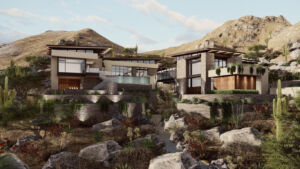Thinking of buying a multi-generational home? Before you take the plunge, consider the unique challenges and rewarding opportunities of bringing three generations together under one roof. In this guide, CEOs and physicians share expert advice on building a harmonious living environment for everyone involved. From prioritizing accessibility features to designing kitchens and bathrooms that cater to all ages, these seven essential insights will help you create a home that meets the diverse needs of every family member.
- Prioritize Accessibility Features
- Create Flexible Living Spaces
- Set Clear Communication and Boundaries
- Plan for Long-Term Flexibility
- Establish Boundaries and Expectations
- Design for Flexibility and Privacy
- Focus on Kitchen and Bathroom Needs
Prioritize Accessibility Features
If you’re considering a multi-generational home, make accessibility your top priority! Start by installing things like lever-style door handles, grab bars, or even widening doorways to help everyone maintain independence, regardless of dexterity or mobility limitations.
Think about key amenities on the main floor: a downstairs bedroom and bathroom can make a world of difference, and if that’s not possible, consider a stairlift. Remember the outdoor spaces, too—adding ramps or raised flower beds makes it easier for everyone to enjoy and contribute to gardening.
Inside, design versatile spaces that support various activities, and, where possible, create private zones so everyone has a bit of their own space. Decluttering and adding non-slip flooring can prevent falls, making the home safer for everyone. With these thoughtful changes, your home can truly support all generations comfortably!
Robin Cherian, CEO, The Canadian Home
Create Flexible Living Spaces
From flipping over 100 houses, I’ve noticed that successful multi-generational homes need flexible spaces that can adapt as family needs change—like a ground-floor bedroom that could work for grandparents now but convert to a home office later. Last year, we helped a family modify their home by adding a separate entrance and small kitchen area for the grandparents, which made a world of difference in maintaining independence. I really recommend focusing on sound insulation and separate HVAC zones—they’re not the most exciting features, but they’ve been game-changers for the families I’ve worked with.
Ryan Whitcher, Founder & CEO, Harmony Home Buyers
Set Clear Communication and Boundaries
When thinking about buying a multi-generational home, my biggest piece of advice would be to prioritize communication and boundary-setting. Before you dive into house hunting, sit down with everyone involved. You’ve got to talk about the nitty-gritty details like who owns what percentage of the house, how much each person will contribute financially, and what happens if someone decides they want out of the arrangement. We did this by getting legal advice to draft an agreement that covered all these bases, making sure everyone’s rights and responsibilities were clear.
Living together across generations, we learned quickly that managing privacy and personal space is key. We chose a house with a layout that allowed for some separation. My parents had their own wing with a private entrance, which was a game-changer. It meant they could have their own space, and we could have ours. We also set up rules for shared spaces, like kitchen use times and cleaning duties, to keep things harmonious. It’s about respecting each other’s need for alone time just as much as enjoying the togetherness.
Handling the unique aspects of this living situation involved a lot of adaptability and ongoing dialogue. We had regular family meetings to address any issues or changes in our lives. If tensions arose, we had a system in place for discussing problems without letting them fester. This setup wasn’t just about sharing a roof; it was about building a community within our family. We also made sure to keep individual interests alive, ensuring everyone had their own hobbies or time to themselves. This balance of closeness and independence has been crucial in making our multi-generational home work smoothly.
Henry Timmes, CEO, Campaign Cleaner
Plan for Long-Term Flexibility
Buying a multi-generational home means being pragmatic about long-term flexibility and talking frankly about up-front finances and daily needs. These homes often mean great financial advantages, such as splitting expenses (even tax benefits, perhaps). But then again, they come with unique challenges, such as finding a balance between privacy and shared spaces. It’s smart to consider how future changes might be needed, whether that includes adding in a separate entrance or adapting spaces for an aging family member.
The practical approach would be to find a floor plan that suits everyone’s needs, which might include homes with private suites or separate entrances. This not only allows for privacy but also enhances resale value, as buyers appreciate the flexibility of a layout.
Financially, ensure that all parties understand their roles: who pays down, who pays the mortgage, who pays maintenance. Sorting this out upfront can help you avoid future conflicts. Also, if more than one person is on the title, consider working with a real estate attorney to establish a clear ownership agreement.
Alexei Morgado, Founder, Lexawise Real Estate Exam Prep
Establish Boundaries and Expectations
If you’re considering buying a multi-generational home, my biggest piece of advice is to set clear boundaries and expectations from the beginning. Living with multiple generations can be wonderfully rewarding—you’re building deep connections and sharing special moments—but it can also be challenging without a plan in place. Different needs, habits, and lifestyles can sometimes clash, so it’s important to have open conversations early on.
When we made the move to a multi-generational living arrangement, we sat down as a family and talked through everything—from household responsibilities to personal space needs. We discussed things like privacy, finances, and caregiving duties, making sure everyone felt heard and had a role they were comfortable with. It wasn’t always easy, and there were adjustments along the way, but setting those expectations helped prevent misunderstandings and resentment.
Another thing that helped us was creating spaces that allowed for both togetherness and alone time. In a multi-generational home, it’s important for everyone to have their own corner to retreat to, as well as communal areas where we could connect. This balance between independence and family time was key to maintaining harmony.
Managing a multi-generational household requires flexibility, communication, and a willingness to compromise, but it’s worth it. The time spent together is invaluable, and there’s something truly special about the support and connection that comes from multiple generations under one roof. With a little planning, it can be an experience that brings a family closer together in meaningful ways.
Barbara Sparacino, MD, FAPA, Physician, The Aging Parent Coach, LLC
Design for Flexibility and Privacy
Plan for flexibility and privacy. Living with multiple generations can be incredibly rewarding, but setting up a home that supports everyone’s needs while fostering a shared environment is essential. Think carefully about the layout and spaces that allow connection and privacy. Features like separate entrances, self-contained living areas, or at least dedicated bathrooms, can make a big difference in helping everyone feel comfortable and independent.
When I helped clients with multi-generational homes, we focused on clear communication early in the process. Each family has unique routines and preferences, so setting expectations and having open discussions about communal and private spaces is essential. It also helps to establish shared responsibilities up front to keep things running smoothly.
One approach that worked well was designing a common area where everyone could come together, like a spacious kitchen or living room, while ensuring each generation had a quiet retreat.
Justin Landis, Founder, The Justin Landis Group
Focus on Kitchen and Bathroom Needs
When planning a multi-generational home, you’ll want to pay specific attention to the kitchen and bathroom. This is coming from an experienced HVAC and plumbing professional.
These spaces are important because every age group has its own needs, especially when it comes to cooking and bathing.
When it comes to the kitchen, I recommend setting up multiple cooking areas to keep things flowing smoothly without crowding. It’s really important to have counters that people can reach. For older family members, I suggest lower counters and cabinets they can easily access, which makes cooking much easier for them. For the younger crowd or anyone who loves to cook, think about a bigger fridge and flexible cooking zones.
Moving on to the bathrooms, think about what each age group needs to make their lives easier and safer. For instance, walk-in tubs are fantastic for older adults, while adjustable shower heads can make showers better for younger people or anyone who’s a bit taller. Consider installing double sinks and more than one toilet, or even adding extra bathrooms. This reduces waiting times and keeps the bathroom from becoming a bottleneck during those busy morning and evening routines.
I also recommend bringing in HVAC and plumbing experts to make sure that everything is perfectly customized to your family’s needs. This attention to detail will help create a comfortable home where people feel welcome.
Making these adjustments can really turn day-to-day life in a home where generations blend together. It’s all about making sure people have what they need to feel comfortable and independent.
John Gabrielli, Owner, Air Temp Solutions




